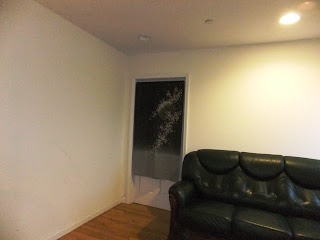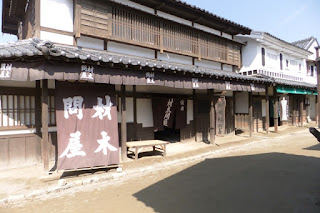Hello and Welcome to
www.nipponcraft.com,
In September 2011, I uploaded an article in this blog about how a noren curtain would fit to a studio room in New York. I would like to add more articles and photos as my proposals. I took these photos at a studio room and a single family apartment that I rent in New York City in 2011, 2012 and 2013. I applied noren to various places and corners of the apartment, and found a noren looked nice for the decor. Furthermore, I have more to address based on cutomers' support in the past.
So, before starting my proposal, let me mention two things to avoid possible misunderstandings on the behalf of the people who are not familiar with noren curtains. At first, every noren curtain has a rod pocket on the top, and you can go through it a 2cm -3cm diameter rod for hanging. (And, please prepare a noren rod or curtain pole on your side.) Secondly, although a noren is called "a curtain", it is not so much soft as it can be bunched up like a window curtain - a noren curtain is just a hanging cloth, and in a case, you will find it a hard textile (especially polyester or hemp).
Most often, the dimensions of the ready-made
noren curtains are 150cm (59") -170cm (67") high and 85cm (33.5") wide for fitting into Japanese standard rooms, but I find these noren are still helpful and look nice at western homes. Please see the following demonstrations for room decorations.
The following presentation is for reference only, and final decision is up to you.
I would recommend to use a noren curtain at a bedroom hallway as a light partitioning. A noren will cut direct sights into bedrooms behind.
This is how it looked like from the bedroom side.
It was also nice to sectionalize a TV living room from a kitchen by hanging a noren. It added more private section sense to the room, and also the pink cherry blossom design looked great with the contrast to the white wall.
You can set a noren together with the door to hide the bedroom behind, and when you close the door the noren will turn into a nice tapestry on the wall as you can see below.
Another place I found nice was a window frame. You can use a noren instead of blinds or still together with blinds. A noren curtain can be a decor at the window and it also prevent a sunshine reflection into the room. Also, the center split of the noren will let wind come into the room gently.
Here let me add again that the noren cannot be bunched up at the curtain rod edge like an ordinary curtain. You need to lift up and close down the window from the center split of the noren.
The issue I noticed while taking this photo is that you might care about the noren width. There is room left at both sides of the window frame ^^);

You could hang a noren curtain at an entryway. I thought the noren gave warm touch to a white concrete wall. Without a noren curtain, the room looked cut-and-dried.
If your room is happened to be messy when you a have sudden guest, a noren might help you. Your guest will probably pay more attentions on the design printed on a noren curtain instead!
My final proposal is to use a noren curtain in front of an entry door for keeping privacy in the room. The noren will cut a direct sight into your room.
I hope you get an inspiration and you will find your own way to utilize noren curtains by reading my blog.
Hanging a noren curtain is easy. All you need is purchase a curtain rod at a home depot - a rod that can be adjusted by the width of a hallway or a window frame. We also sell a
noren rod adjustable between 79cm-105cm
(31" to 41-5/16") . A rod pocket is already equipped on a upper side of a noren curtain, as I mentioned previously.
I hope Japanese noren curtains will contribute to your room interior. A noren curtain is merely a cloth with a split in the center, but I believe that it can be helpful also at western homes and that wide varieties of designs printed on the noren will add warm touch to your room.
Thank you for visiting our blog!



































